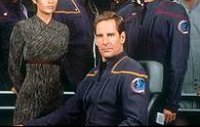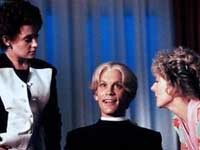For the record, we definitely did not have Star Trek: Enterprise on the brain when we named our son Archer.

Captain Archer,
not the same as…

Captain Archer
Americlecticintellectica
For the record, we definitely did not have Star Trek: Enterprise on the brain when we named our son Archer.


 When writing about the appeal of the original Star Trek it has become de rigeur to cite its optimistic vision for the future — in which war, racial strife, etc. have been overcome — especially since it appeared during the turbulence of the 1960’s. But I think the real answer is something deeper and more essential.
When writing about the appeal of the original Star Trek it has become de rigeur to cite its optimistic vision for the future — in which war, racial strife, etc. have been overcome — especially since it appeared during the turbulence of the 1960’s. But I think the real answer is something deeper and more essential.
 First, a digression. In The Adventures of Baron Munchausen, the Baron, that lovable spinner of fantastical tall tales, is opposed by “The Right Ordinary Horatio Jackson,” a literal-minded and distinctly unlovable bureaucrat who prizes order and rationality over the creative chaos of the Baron’s world. The film depicts rationality robbing the world of adventure and romance.
First, a digression. In The Adventures of Baron Munchausen, the Baron, that lovable spinner of fantastical tall tales, is opposed by “The Right Ordinary Horatio Jackson,” a literal-minded and distinctly unlovable bureaucrat who prizes order and rationality over the creative chaos of the Baron’s world. The film depicts rationality robbing the world of adventure and romance.
American pop culture has always been hard on men of reason, who usually come off as amoral, insensitive, clumsy, narrow-minded, unpoetic, socially inept, or downright mad. Dreamers, lovers, men of action — they are the heroes, and anyone employing logic is a mere detractor if not an out-and-out villain.
In the popular imagination, the intellect is suspect. Thinkers in general, and scientists in particular, are a haughty elite, the priests and guardians of an occult sect with its own impenetrable apocrypha and incomprehensible dialects. They set themselves up as authorities on various subjects and make pronouncements based on arcane knowledge that are never to be trusted, because there’s always a contradictory pronouncement just around the corner.
But in reality, what can be more democratic than science? It’s the ultimate leveler; anyone can be an authority. Science isn’t a particular collection of knowledge or a particular place or particular people. Science is a method, famously encapsulated by Richard Feynman as: “1. Make a guess. 2. See if you’re wrong.” Anyone who thinks according to these rules, and follows fearlessly where the reasoning leads, is a scientist.
If democracy is the founding principle of America, science and rationality are its true religion. They are the bedrock on which its political and industrial institutions are built, even at times when science seems temporarily discredited by the prevailing political fashions of the day.
Yet, even as science is central to the American experience, it gets short shrift in popular culture. Often marginalized, occasionally trashed, seldom if ever was it celebrated properly — until Star Trek. The accomplishment of Star Trek, and the true source of its enduring appeal, was its portrayal of a future in which rationality does not kill adventure and romance but creates them, satisfying the unmet need of Americans to see their society validated — or, as one like-minded fan commented recently,
It isn’t Star Trek’s “optimism” that made it great. It’s the idea that in the future the Carl Sagans of the universe will be in charge and successfully run society on the principles of secular humanism and science while the George Bush and Dick Cheneys of the universe are Klingons. Star Trek is about the promise of a new Enlightenment […]
As a champion of romantic rationality and a lifelong Star Trek fan I am encouraged by the selection of Dawkins as BBC’s Person of the Year. Atheism has always been the belief-that-dares-not-speak-its-name. Even at the height of the Age of Reason, Thomas Jefferson, whom we might recognize as an atheist, called himself a Deist. But this news about Dawkins, and other harbingers (here, here, and here), suggest that atheism is coming out of the closet in a big way, which can only happen in an environment favorable to rationality. Can it be that the recent wave of anti-intellectualism in the Western world finally crested, crashed on the jagged rocks of the reality-based community, and is now receding?
That would be good news for the back-to-its-roots Star Trek movie now in development.
I finished disc six just last night and HOLY CRAP! I got it in the mail to Netflix first thing this morning hoping for disc seven to arrive by Wednesday. I logged in to Netflix to see the episode titles on the next disc… and discovered that disc seven is merely the “special features” disc with no new episodes on it. I finished season two without even realizing it, and now I can’t see season three until it comes out on DVD. Bogus!
The first is by Nancy Cartwright as Bart Simpson in the Simpsons episode, “Homer Alone.” Bart and Lisa are consigned to the house of their aunts Patty and Selma for the weekend. Bart rummages through their closet and finds a plastic gun, which he starts pointing around the room going, “Bang! Bang!” Lisa says, “Bart! That’s a blackhead gun!” which prompts Bart to cast it aside with a pronounced, “Eww!”
 The second is by Glenne Headley as Trish in the movie Making Mr. Right (the only movie I know of with a character named Glickstein in it, which is not the only reason to check it out). “Ulysses” (John Malkovich) lies in a heap on the kitchen floor, his pants around his knees and his head torqued 180 degrees around on his neck. Trish is in hysterics as she describes to Frankie (Ann Magnuson) how she seduced and made love to him, then he spazzed out and collapsed in that unnatural state, apparently dead. Frankie breaks this news to her: “You didn’t make it with my cousin, you made it with my android.” Trish utters the most memorable “Eww!” in movie history.
The second is by Glenne Headley as Trish in the movie Making Mr. Right (the only movie I know of with a character named Glickstein in it, which is not the only reason to check it out). “Ulysses” (John Malkovich) lies in a heap on the kitchen floor, his pants around his knees and his head torqued 180 degrees around on his neck. Trish is in hysterics as she describes to Frankie (Ann Magnuson) how she seduced and made love to him, then he spazzed out and collapsed in that unnatural state, apparently dead. Frankie breaks this news to her: “You didn’t make it with my cousin, you made it with my android.” Trish utters the most memorable “Eww!” in movie history.
Star Trek is 40 today. Happy birthday, Star Trek! Yes, it’s longer than Alex has been around, and yes, like Alex, no one originally expected it to last anything like this long. But the similarities end there. Star Trek never curled happily by my feet or licked my face to cheer me up.
What can I say about Star Trek that hasn’t already been said many times before? Well, I do have a couple of cute personal stories from when I was a kid in the 70’s and Star Trek had not yet transformed into a cultural touchstone. (It was still the shameful secret love of closeted nerds everywhere.)
One dim memory from a summer at the Pine Knoll bungalow colony in Monticello: my friend Michael wanted to “play Star Trek,” which at that point I’d never seen. I was assigned the role of Scotty, who (Michael explained to me) kept the spaceship in working order. I got into character as best I could, complaining about broken gears and attempting to fix them, but was berated by Michael who said, “The Enterprise doesn’t have gears, it has dilithium crystals!”
A few years later, having by now seen plenty of Star Trek on TV (the original series and the animated one), my friend David and I were confirmed Trekkie nerds. My mom took us on a subway ride into Manhattan to visit a short-lived mecca for Trekkies called “The Federation Trading Post,” a store full of Trek memorabilia, which at that time was sparse and hard to find. The tiny store was itself hard to find! But once you did, you could buy phaser and communicator props, scripts of all 79 episodes and audio cassettes of some (not videocassettes — VCRs wouldn’t appear in average homes for a few more years), rubber Spock ears, all the James Blish books, etc. Most of the really cool things were not within our budget, but we did score The Starfleet Technical Manual, the Star Trek Blueprints, a couple of blank Trek-uniform shirts and the insignia patches and gold braiding to sew onto them. I got a gold “command department” shirt; David got a blue “science” one. Back at home, I asked my mom to sew on my insignia and braids, showing her the exact specifications (to the millimeter!) from the Star Trek Technical Manual. Bless her, she made it perfect. Thanks, Mom! For a short time thereafter, David and I instituted our own “Starfleet Academy” at which we would wear our “uniforms” and practice flipping each other and rolling to our feet á là Captain Kirk.
 Of course I’ve long outgrown most of that, but to this day there is still a model of the Enterprise-A on my desk. It’s the most beautiful of all sci-fi spaceships.
Of course I’ve long outgrown most of that, but to this day there is still a model of the Enterprise-A on my desk. It’s the most beautiful of all sci-fi spaceships.
In January of last year I sent a letter to Comcast, my cable TV provider, complaining about the removal from my “premium” cable service of five premium channels. (The letter is reproduced at the end of this post.) I received an unsatisfactory reply. It was the last in a string of insults, from exorbitant monthly fees (in excess of $100) to crappy image quality full of digital compression artifacts.
Compounding my cable TV complaints was the fact that I seldom actually got to watch anything. Having two small kids and a long daily commute while both parents (try to) work full time has that effect. When I did get some time to watch TV, I worked through a gigantic TiVo backlog. The Sopranos and Shield episodes that I watched were more than a year old when I finally watched them.
Which got me thinking: if I don’t watch things until they’re stale anyway, why do I even need cable TV? All the movies I could want to see, and most of the good TV shows, get released on DVD sooner or later; and a Netflix membership costs about one-eighth the combined total of Comcast “Digital Platinum” and TiVo.
It was an obvious decision to make, but I dragged my feet for a long time. Except for a pauper year or two in college, I’d had cable TV almost continually since 1976. I’m also a considerable movie buff. Give up cable, just like that? What would I do when I feel the urge to channel-surf at 12:30am? And what about dumb little guilty pleasures like Unwrapped which, even if it is ever available on DVD, I knew would never rise to the top of my Netflix queue?
Though it took another eight months, and Andrea doubted I’d ever actually go through with it, in the end simple economics won out, and we’ve now been cable-free for almost a year. At the beginning it was hard, as with kicking any habit, but only very briefly. In a year, the only time I’ve really missed having cable was for the Superbowl. Meanwhile, thanks to Netflix, I’ve recently watched entire seasons of Deadwood, Veronica Mars, and I Dream of Jeannie; and movies such as Munich, King Kong, Wedding Crashers, MirrorMask, and much more. There’s no live sports and there’s no channel surfing; and while you might linger guiltily on the latest Emanuelle movie on Skinemax when channel-flipping, you’re not very likely to bother actually renting it. But in all other respects it’s as good as cable. Better, in a lot of ways, because there are no commercials and no wading through junk you don’t want to see.
Now that we’re off the pop-culture grid, as it were, it’s strange to see it from the outside. It’s a tinfoil-hat cliché, easily dismissed, to say that the establishment controls the populace through television. Anyone with a little media savvy can recognize TV’s propaganda and soothing pap for what they are and claim to be immune, or at least aware. But having stepped out of that stream I’m astonished at just what a blatant barrage of never-ending manipulation TV really is. Savvy or not, you can’t fully appreciate it while you’re in it. Even though I seldom watched anything but the best-quality movies and TV shows, the barrage still seeped in through the cracks: the commercials, the network “bumpers,” the pop-ups in the corners and margins of the screen, the glimpses of other programs. And while it is easy to recognize and dismiss the obvious propaganda and pap, there are a thousand more subtle ways in which your consent is being manufactured. I don’t mean to allege a vast mind-control conspiracy; it just seems to be what you get when you organize government, commerce, and mass media the way we have.
So don’t kill your TV, exactly, but do take total control of what you see on it. Cancel your cable. Keep your money. It may seem right now like you can’t live without it (“How can one insulated wire bring so much happiness?” –Homer Simpson), but if you make it to the other side I promise you’ll wonder what took you so long.
And now that I’ve written that, if we lose the fight for net neutrality, the telecoms may arrange for this blog post to disappear into /dev/null.
Here is the letter I sent to Comcast early last year.
I’m a subscriber to Comcast Digital Cable at the “Platinum” level of service, which includes all premium channels. Recently I learned that five of those channels have been removed from my lineup. They were:
- Encore True Stories East (527)
- Encore Action East (529)
- More MAX East (564)
- Showtime Extreme East (581)
- The Movie Channel Xtra East (592)
Previously I had 49 premium movie channels, now I have 44, so this was a 10.2% reduction in service.
When I called Comcast Customer Service to complain, you tried to persuade me that this is not a reduction in service at all. Each of the removed channels, you explained, is the east coast feed of another channel whose west coast feed I still receive — the same programs, shifted by three hours.
But that argument is not valid. At this moment, for example, Encore True Stories East is showing Quiz Show, while Encore True Stories West is showing Gangs of New York. If I sat down at the TV right now and I still received both channels, I could choose to watch either one; but now I can only watch Gangs of New York. My choices are therefore fewer than before. Yes, I could choose to wait three hours and watch Quiz Show on the west coast feed, but by then I may be sleeping, or busy, or watching something else.
You also explained that the channels were removed to make room for others, such as the DIY network and WGN. But these are not premium movie channels and no one can argue they are comparable in value to the channels they supposedly replaced.
Comcast has the right to choose what channels to include in its service. But if you remove channels that I’ve been paying for, then you must also reduce the rate you charge me.
My channel lineup continues to include both the east and west coast feeds of some premium movie channels, such as HBO. But if it’s Comcast’s policy that one feed is equal to two, I’m concerned that there may be further uncompensated service reductions in the future.
Finally, I’ve just learned that the cost of Comcast’s “Platinum” service is about to go up by three dollars per month, or about 6%. Previously I was paying about $1.04 per channel for my premium movie channels. Now, between the service reduction and the rate increase, I’ll be paying $1.23, effectively an 18% increase.
I insist that Comcast restore my lost service or reduce my rates proportionately.
 I went to elementary school at P.S. 196 in Forest Hills, NY. Among my friends there was a girl named Amy Linker. A few years after we all graduated, Amy landed a co-starring role opposite Sarah Jessica Parker in a popular TV sitcom called Square Pegs.
I went to elementary school at P.S. 196 in Forest Hills, NY. Among my friends there was a girl named Amy Linker. A few years after we all graduated, Amy landed a co-starring role opposite Sarah Jessica Parker in a popular TV sitcom called Square Pegs.
 While Amy’s show was on the air, I attended Hunter College High School in Manhattan, where among my new friends was a girl named Cynthia Nixon. Several years later, Cynthia landed a co-starring role opposite Sarah Jessica Parker in a popular TV sitcom called Sex and the City.
While Amy’s show was on the air, I attended Hunter College High School in Manhattan, where among my new friends was a girl named Cynthia Nixon. Several years later, Cynthia landed a co-starring role opposite Sarah Jessica Parker in a popular TV sitcom called Sex and the City.
What does it mean? And, which of my female college classmates will be SJP’s next TV co-star?
On my first date with Andrea, way back in 1988 (“Did you hear Michael Keaton is going to play Batman?!”), we double-dated with my friend Bruce and Andrea’s roommate Katie. We spent part of the night at a bar called Monsour’s in the “Sliberty” section of Pittsburgh, drinking and dancing in their cheesy backroom disco. At one point the DJ announced a trivia contest. The first person to answer it correctly would win an LP. His question was, “In what year did I Dream of Jeannie premiere on TV?”
I had a pretty good educated guess. I knew that shows like Batman and Star Trek, both of which premiered in 1966 (which I knew because I’ve been a big fan of both and because I was born in 1966), were prominently marketed as being “In Color.” And I knew, from watching too many reruns on TV in my childhood, that the first season of I Dream of Jeannie was in black-and-white. A major studio sitcom like Jeannie would not have premiered in black-and-white at the same time that the networks were premiering their shows in color. So Jeannie premiered in 1965 or earlier — but not much earlier, because by its second year Jeannie was in color, which was still new enough in 1966 that it formed a major part of a show’s promotional campaign; and because it was descended from a line of shows in the ordinary-guy-living-with-someone-or-something-magical genre (including Mister Ed, My Favorite Martian, and Bewitched), a genre that was itself no older than the 1960’s.
So 1964 or 1965. I guessed 1965 — and I was right! I won the LP. (I forget what it was.) Andrea was duly impressed. “And today that woman is my wife.”
(Nowadays I would just google the answer under the table with my Hiptop, but back then men were men.)
Today too I have season 1, disc 1 of I Dream of Jeannie at home from Netflix. We watched a couple of episodes yesterday, and they were in color! Alas, a trivia fact with which I wooed my wife has gone down the memory hole.
At least it makes sense to colorize Jeannie, with its faux-Persian costumes, genie-magic visuals, Florida setting, and parade of Playboy-era sex kittens (on the arm of bachelor astronaut Roger Healey). And to this untrained eye the colorization looks well done. But I will never understand what possessed someone to colorize Dynamite Hands. Dynamite Hands is the first of two “features” in Movie Movie, a film that harks back to the days of seeing double features for a nickel. Dynamite Hands is an affectionate parody of every morality play ever set in a boxing ring (notably Body and Soul). It’s the “B” picture before the main attraction, Baxter’s Beauties of 1933, a Busby-Berkeley-style musical. George Burns introduces the films by saying that, back in the old days, movies were in black-and-white — “except sometimes when they sang, it came out in color.” Dynamite Hands was in black-and-white and Baxter’s Beauties was in color — only someone colorized Dynamite Hands for cable TV, making a liar of George Burns.
Idiots.